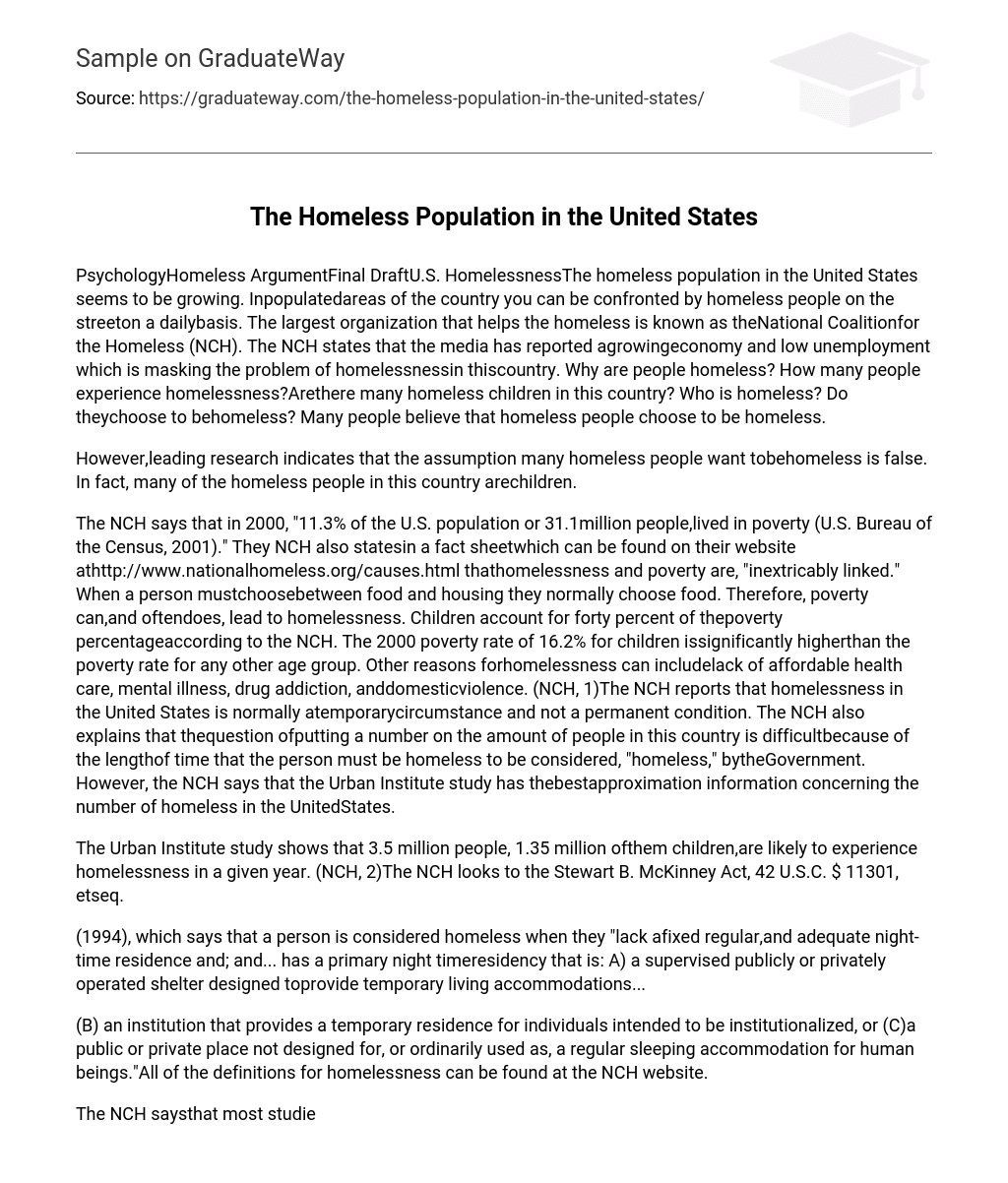PsychologyHomeless ArgumentFinal DraftU.S. HomelessnessThe homeless population in the United States seems to be growing. Inpopulatedareas of the country you can be confronted by homeless people on the streeton a dailybasis. The largest organization that helps the homeless is known as theNational Coalitionfor the Homeless (NCH). The NCH states that the media has reported agrowingeconomy and low unemployment which is masking the problem of homelessnessin thiscountry. Why are people homeless? How many people experience homelessness?Arethere many homeless children in this country? Who is homeless? Do theychoose to behomeless? Many people believe that homeless people choose to be homeless.
However,leading research indicates that the assumption many homeless people want tobehomeless is false. In fact, many of the homeless people in this country arechildren.
The NCH says that in 2000, “11.3% of the U.S. population or 31.1million people,lived in poverty (U.S. Bureau of the Census, 2001).” They NCH also statesin a fact sheetwhich can be found on their website athttp://www.nationalhomeless.org/causes.html thathomelessness and poverty are, “inextricably linked.” When a person mustchoosebetween food and housing they normally choose food. Therefore, poverty can,and oftendoes, lead to homelessness. Children account for forty percent of thepoverty percentageaccording to the NCH. The 2000 poverty rate of 16.2% for children issignificantly higherthan the poverty rate for any other age group. Other reasons forhomelessness can includelack of affordable health care, mental illness, drug addiction, anddomesticviolence. (NCH, 1)The NCH reports that homelessness in the United States is normally atemporarycircumstance and not a permanent condition. The NCH also explains that thequestion ofputting a number on the amount of people in this country is difficultbecause of the lengthof time that the person must be homeless to be considered, “homeless,” bytheGovernment. However, the NCH says that the Urban Institute study has thebestapproximation information concerning the number of homeless in the UnitedStates.
The Urban Institute study shows that 3.5 million people, 1.35 million ofthem children,are likely to experience homelessness in a given year. (NCH, 2)The NCH looks to the Stewart B. McKinney Act, 42 U.S.C. $ 11301, etseq.
(1994), which says that a person is considered homeless when they “lack afixed regular,and adequate night-time residence and; and… has a primary night timeresidency that is: A) a supervised publicly or privately operated shelter designed toprovide temporary living accommodations…
(B) an institution that provides a temporary residence for individuals intended to be institutionalized, or (C)a public or private place not designed for, or ordinarily used as, a regular sleeping accommodation for human beings.”All of the definitions for homelessness can be found at the NCH website.
The NCH saysthat most studies show that single men are more likely to be homeless thansingle women.
The NCH also states that 39% of the homeless population are children orunder the age of18. The largest age group of homeless that the NCH reported was the ages 31through 50which accounted for 51% of the homeless population. Families also accountfor a largeportion of the homeless population. However, some laws do not recognizethem ashomeless because they state that homeless people are unaccompanied. (NCH,3)The overwhelming majority of homeless persons want to get off thestreet, andinto a residence. Many people make bad choices at some time in their lives.
Among thoseon the economic margin, a bad choice can result in homelessness. Thealienation anddeprivations accompanying homelessness do not help people learn new andbetterchoices. Sometimes, the effect is just the opposite. (SDRTH, 1)It is often disturbing to see homeless people trying to survive onthe streets.
But blaming people who do not have the means to solve the problem is notuseful.
Helping to do something positive about homelessness is an effective way todeal with thediscomfort of seeing these daily conditions. (SDRTH, 1)choices. Sometimes, the effect is just the opposite. Top of FormIt is personally disturbing to see homeless people trying to survive on thestreets. But blaming people who do not have the means to solve the problemis not useful. Helping to do something positive about homelessness is aneffective way to deal with the discomfort of seeing these daily conditions.
It is personally disturbing to see homeless people trying to survive on thestreets. But blaming people who do not have the means to solve the problemis not useful. Helping to do something positive about homelessness is aneffective way to deal with the discomfort of seeing these daily conditions.
Bottom of FormIt is personally disturbing to see homeless people trying to survive on thestreets. But blaming people who do not have the means to solve the problemis not useful. Helping to do something positive about homelessness is aneffective way to deal with the discomfort of seeing these daily conditions.





